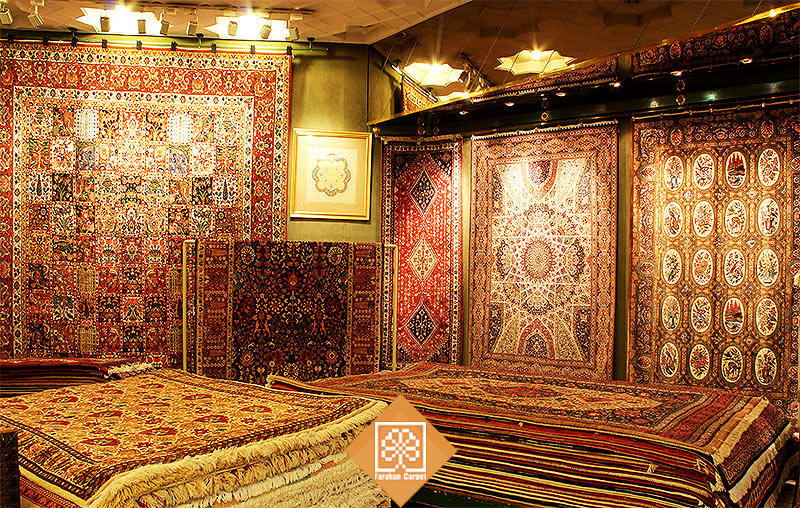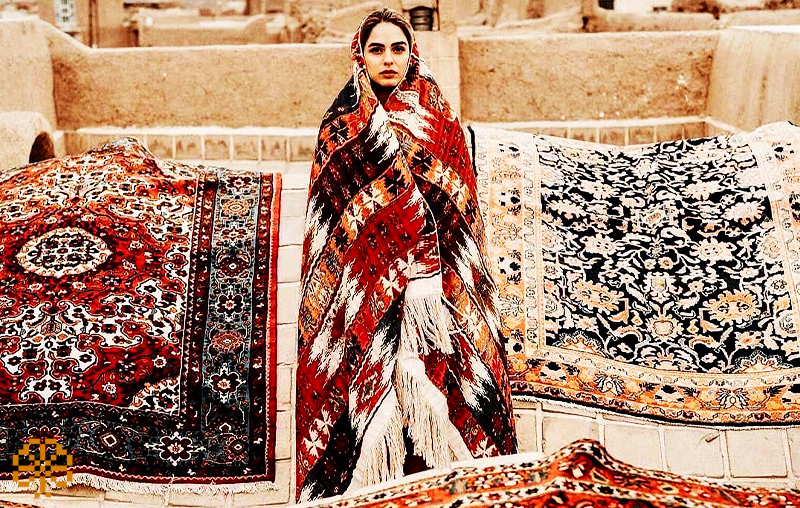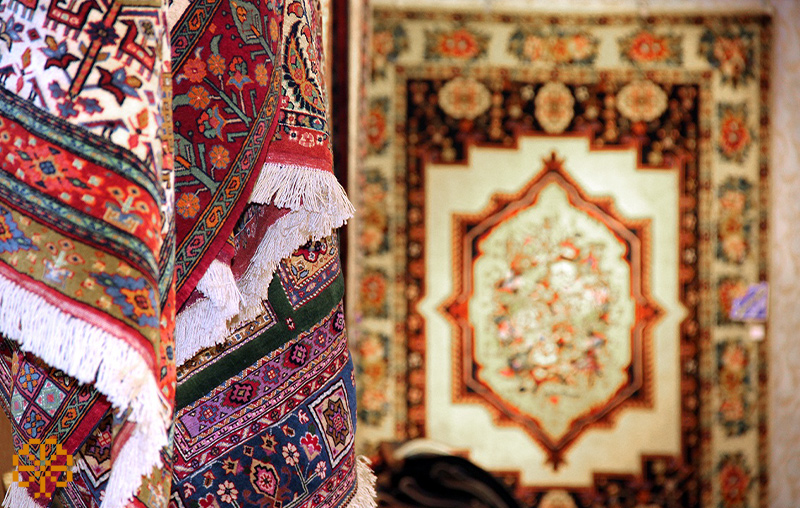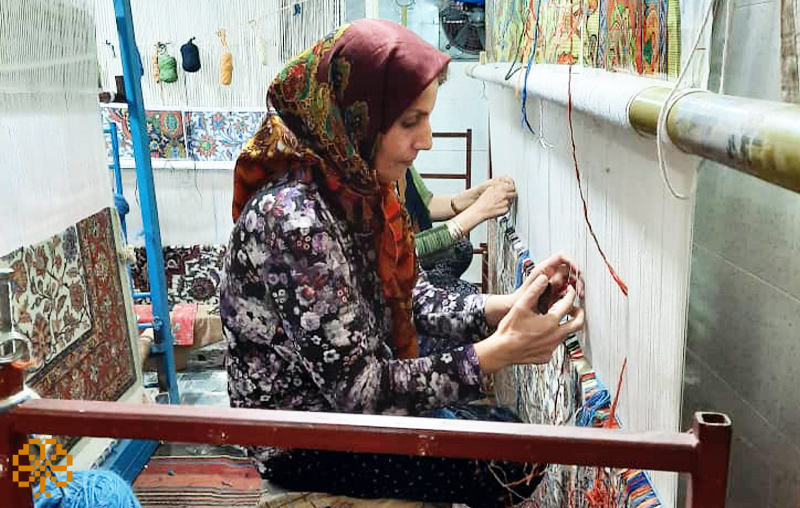Types of handmade carpets in terms of area, material and …

Types of handmade carpets and recognizing different models is one of the most common things that many lovers and buyers of these rugs are looking for. When someone asks us what kind of carpets do you have, our answer is definitely in what sense? You can consider different categories for carpets.
In this article of Farahan carpets, we intend to examine the most important types of handmade carpets in different categories so that if you intend to buy carpets, you can identify different types and compare them.
What are the types of handmade carpets?
As you know the main category that exists about carpets; There are two cases of machine-made and hand-made. In the past, we have carefully studied the ways of distinguishing hand-made and machine-made carpets. Is a rug to buy, we will check.
Hand-woven rugs in terms of dimensions
Handmade rugs can take many sizes, but there are four general standards that have the highest sales: 6 meters, 9 meters, 12 meters and 24 meters.
It is necessary to point out that none of these dimensions has any advantages or disadvantages over the other, and your only criterion for choosing them is the dimensions of the house.
Of course, sometimes it is observed that people prefer to choose 6 and 9 meter areas that can be associated with high flexibility and power of action when changing the decoration or changing the apartment.
Different names have been chosen for different types of handmade carpets in terms of dimensions, which indicate specific dimensions:
Carpet
In general, carpets that are in the sizes of 3 * 2 meters, 3.5 * 2.5 meters, 4 * 3 meters and 4 * 6 meters are called carpets, which depending on the size of them are small, medium, They also say big and very big.
Certainly, carpet can be introduced as the most popular and widely used option compared to other dimensions of carpet, which we will get acquainted with in the following, to the extent that even we use the name of carpet as a substitute for carpet.
rug
Rugs are hand-woven carpets that have dimensions of less than 4 square meters and are also divided into two main categories: rug rugs and curtain rugs.
There is a definite and standard size for rugs; The dimensions of the prostration rugs are 2.40 x 20.2 and the dimensions of the curtain rug are 2.5 x 1.5, which is fine woven.
kallegi
Among the types of handmade carpets, there are options that we may not be very familiar with and do not know their names. Less than 4 meters.
Common dimensions for the head are 1.5 x 3 m, 3 x 7.7 m and 2.7 x 2.
Kenare
You have probably seen this type of handmade carpet a lot, a carpet that is used for corridors and stairs and its width varies from 1.07 to 0.5 meters and its length varies from 3 to 10 meters.
One and a half and one and a quarter
Carpets whose dimensions are 1.5 x 1.04 and 1.60 x 1.60 m are called half and half. Also, carpets that are 0.80 x 1.30 meters are referred to as zare and chark.
Back
In ancient times, the backrest was the same as the large supports that rest on the wall. The backs used.
Generally to rugs with an area of less than a square meter. The most common back size is 90 x 60 cm. Of course, in the Gorgan and Bojnourd regions, a kind of kilim is woven separately for the backs of the backs and the inside is filled with chicken feathers and clouds, which is called mushroom.
Padare
The last option among the types of handmade carpets in terms of size and dimensions is a pad that you are probably completely familiar with. In general, small rugs that are woven to the size of the front door are called padri.
Read more: Advantages and disadvantages of handmade carpets and review 7 important cases
Types of handmade carpets in terms of raw materials
Among the specifications of handmade carpets, one of the important features is the fibers and yarns used in it. Handmade carpets generally have three dimensions, length or warp, fabric or width, lint or height, which creates different shapes and types in handmade carpets.
The presence of quality raw materials has become one of the main aspects of distinguishing hand-woven carpets from other carpets. Consider that we should act as follows:
1. All-wool carpets: These types of carpets, as their name suggests, are the fabric, weft and lint of all three animal wools, this is the main rule that we see among nomadic carpets, but today in This type of carpet is used in many cases in the warp and weft of cotton and only the lint is wool.
2. All-silk carpets: Handmade carpets that have beauty and high price, and the fibers used in the lint are made of silk.
3. Silk flower carpets: In this type of carpets that are woven from wool, the difference is that silk is used instead of woolen lint in the patterns and around the edges, and usually the weft of these carpets is made of silk. .
4. Silk floor carpet: This type of carpet is also a kind of opposite to the previous model, and the carpet woven from wool, has used silk lint only in its field instead of using woolen lint.
5. Pulp carpet: In their field, thick and thin fabric is used and the role of its flowers and shrubs has longer villi and the so-called fluffy.
6. Silk fluff rugs: This type of rug, which is not very common due to its high price, has fluff and silk fluff, which is sometimes made of cotton or linen.
Types of handmade carpets in terms of design
The next item that we want to examine among the types of handmade carpets is the type of design used in hand-woven carpets, which is divided based on the city and the woven area, the most important of which are:
1. Kerman handmade carpets: Kerman handmade carpets can be considered in the category of naturalistic carpets, full of work and full use of fine motifs throughout the carpet, the most famous designs of which are: vegetable, patchwork, tree, shrub, Quranic frame, image, Afshan and… which is the famous vase design, is one of the masterpieces of Safavid period carpets.
2. Kashan handmade carpets: The high design and quality of Kashan carpets has made its carpets one of the best Iranian carpets and has gained worldwide fame. Today, in Kashan carpet, the elastic and bergamot map is used more, which is known as Shah Abbasi elastic and bergamot.
3. Tabriz handmade carpets: You have probably heard the fame and reputation of Tabriz carpets, very valuable carpets that are also kept in many collections and museums around the world.
Tabriz carpet is woven in various designs and the variety of Tabriz carpet designs is very high. Many Tabriz carpets are woven with finesse and precision and become very thin. Tabriz carpet is often woven with wool or silk and its weaving is usually done with cotton or silk and very rarely with wool.
4. Isfahan handmade carpet: The main structure of most Isfahan carpet designs follows the pattern of elastic and bergamot. Beautiful Islamic motifs and their rotations are clearly seen in the elastic structure, bergamot and text of the carpet, and frames made of Islamic motifs can be seen in the margins of these carpets.
Other appearance and design features used in Isfahan handmade carpets include the rotation of Khatai stems as a sub-pattern with Islamic stems along with the beautiful flowers of Shah Abbasi.
6. Farahan handmade carpet: Durable carpet that is woven with high quality wool and the height of its piles is basically very short, but you should note that this is a description of classic and old Farahan carpet. Let’s not forget that Farahan carpet is world famous.
5. Nain handmade carpets: Nain carpets can be introduced in terms of design from Isfahan carpets. Extensive use of elastic and bergamot designs with a combination of Islamic and Khatai motifs in Nain handmade carpets is so much that Nain handmade carpets are often known with elastic and bergamot designs.
6. Harris handmade carpet: Harris carpet is one of the symbols of Iranian and Iranian art in the world, and seeing its patterns and drawings almost well explains the reason for the popularity of this carpet in the world.
One of the characteristics of Harris handmade carpet designs and drawings is that no curved lines are used in its texture, which of course makes what Beaufort can see is the use of Islamic geometric shapes and broken lines.
7. Qom handmade carpets: Among the types of handmade carpets, the tail option reaches Qom carpets. It should be noted that compared to other types of handmade carpets; Qom carpets do not have a strong background and history, and in the past, due to the use of poor quality materials, the carpets woven in this city were very thick and coarse in texture.
But today, the carpets of this region are famous for their order and in knots and fabrics. There is so much order in the weaving of carpets in this area that sometimes it is difficult to distinguish them from machine-made carpets.
8. Sarooq handmade carpet: The general structure and type of texture of Saroogh carpet is fine-textured, in which the size of the villi is very short.
In ancient times, most of the carpets and rugs in Sarough were inspired by the role of bergamot and the color of the text of most of them was cream and azure, but over time these designs changed to some extent and today most of the maps of this area are in the form of a global flower design. And leaves.
9. Bakhtiari handmade carpets: It is interesting to know that Bakhtiari women and girls use a method that is less common in other parts of Iran and even the world, they use basically no pre-designed designs for their textures. They do not and use mental roles for their tissues.
10. Sultanabad handmade carpet: One of the most important features of Sultanabad or Arak carpet is its comfortable and suitable adaptation to modern and European decorations, which has made it very popular for export.
Arak carpet has a very high and varied design, including: bergamot elastic, Afshan, Shah Abbasi, forest, hunting ground, tree and screw, brick, Sheikh Safi, Islamic, henna, single plant, huge map, plant, goat horn, Mostofi and Golriz and Lillian.
Types of handmade carpets in terms of structure
Modern and classic carpets are another category that is used for handmade carpets, but it is necessary to mention that this classification is also valid for machine-made carpets.
Classic handmade carpet: Classic carpet is a carpet that is woven according to the usual principles and rules of old and its designs and drawings are traditional and old.
The colors used in these carpets are generally soft and soothing. In terms of variety in color scheme, the design is very wide.
Modern handmade carpets: It is true that in general, most carpets are still of the traditional type, but the will of the people has led to the expansion of products that are different from the past.
In modern handmade carpets, the material of the work has not changed and what has changed is the type of design, texture, appearance, colors and a bit of raw materials used, the most important of which is the use of small and minimal patterns that have simple geometric shapes and It is bulky that these shapes are located at a great distance from each other.
Types of hand-woven rugs in terms of local style
Well, we come to know the different types of carpets in terms of local style and their special features; You are probably familiar with their names and appearances.
1. Rural handmade carpets: Carpets that can be introduced as a symbol of the emergence of hand-woven carpets. Carpets without design and pre-determined pattern, which are basically woven in small sizes and are in the form of a half and a half, back, side and vault.
2. Nomadic carpets: Nomadic carpets may not be very different from handmade carpets at first glance, but in this type of handmade carpets you will encounter designs that are taken from the heart of the nature of the tribal living environment. And the type of texture is coarse and coarse texture.
3. Machine-made carpets: With the expansion of industry and population growth, the need to produce carpets in larger volumes led to the establishment of carpet weaving workshops in cities and woven carpets with better structure. Machine-made carpets are generally delicate and have a high number of designs and designs.
Today, a large number of weaves are machine-made carpets, and almost all rural and nomadic carpets are approaching machine-made carpets.
All kinds of handmade carpets in terms of elegance
The number of handmade carpets can be introduced as one of the most important characteristics of a handmade carpet, from which the quality, price and elegance of a carpet can be recognized to some extent. We are all familiar with the name density and fully understand its meaning. Usually, handmade carpets are subtly divided into three important groups in terms of elegance as follows:
Coarse weave carpet: It is a carpet that has a range of 15 to 30 rows. (Ie every 15 cm is woven between 15 to 30 knots)
Semi-fine and fine weave rugs: From 30 to 45, semi-fine rugs and from 45 to 60 rows and above, are considered fine weavers (for every 7 cm of width, the number of knots should be from 30 to 45).
Premium carpet: from 90 ridges to ballast. Among the types of handmade carpets, this type of rug has a higher price than other options, and today, new examples are presented in exhibitions that claim Hezarraj.
Types of handmade carpets, texture type
The last option that we are going to examine among the types of handmade carpets is the type of texture of these carpets, which is divided into three main categories based on the placement of the warp and weft.
1. All-round carpet: if we want to express it simply; A carpet with a knot arch at the back is 90 degrees and is a kind of deep grooves behind the carpet. The main feature of this type of carpet is the short distance between the threads and the presence of strong texture.
2. Carpet roll: As can be guessed; The texture of this type of rug is less strong than that of all-rolled rugs. In this type of rug, the threads are spaced about a diameter apart. The weave of the bed is a fabric and is woven in the form of a mat, that is, in each ridge, the warp is turned upside down and the threads are seen one by one from behind the carpet.
3. Half roll carpet: In this type of carpet, the knot arch behind the carpet is 45 degrees.
And last but not least, the headline made you read this article about how to make a living. The article is accompanied by a question or ambiguity, you can share it with us in the comments section.







